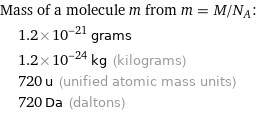Input interpretation

bromocresol green, sodium salt | molar mass
Result
![Find the molar mass, M, for bromocresol green, sodium salt: M = sum _iN_im_i Plan: • Write the chemical formula and gather atomic masses from the periodic table. • Determine values for N_i and m_i using these items. • Finally, compute the mass. Write the chemical formula: NaOSO_2C_6H_4C[C_6HCH_3Br_2OH]:C_6HCH_3Br_2(:O) Use the chemical formula to count the number of atoms, N_i, for each element: | N_i Br (bromine) | 4 C (carbon) | 21 H (hydrogen) | 13 Na (sodium) | 1 O (oxygen) | 5 S (sulfur) | 1 Look up the atomic mass, m_i, in g·mol^(-1) for each element in the periodic table: | N_i | m_i/g·mol^(-1) Br (bromine) | 4 | 79.904 C (carbon) | 21 | 12.011 H (hydrogen) | 13 | 1.008 Na (sodium) | 1 | 22.98976928 O (oxygen) | 5 | 15.999 S (sulfur) | 1 | 32.06 Multiply N_i by m_i to compute the mass for each element. Then sum those values to compute the molar mass, M: Answer: | | | N_i | m_i/g·mol^(-1) | mass/g·mol^(-1) Br (bromine) | 4 | 79.904 | 4 × 79.904 = 319.616 C (carbon) | 21 | 12.011 | 21 × 12.011 = 252.231 H (hydrogen) | 13 | 1.008 | 13 × 1.008 = 13.104 Na (sodium) | 1 | 22.98976928 | 1 × 22.98976928 = 22.98976928 O (oxygen) | 5 | 15.999 | 5 × 15.999 = 79.995 S (sulfur) | 1 | 32.06 | 1 × 32.06 = 32.06 M = 319.616 g/mol + 252.231 g/mol + 13.104 g/mol + 22.98976928 g/mol + 79.995 g/mol + 32.06 g/mol = 720.00 g/mol](../image_source/c3d9d4b9d244f2be51ca30320547dc1d.png)
Find the molar mass, M, for bromocresol green, sodium salt: M = sum _iN_im_i Plan: • Write the chemical formula and gather atomic masses from the periodic table. • Determine values for N_i and m_i using these items. • Finally, compute the mass. Write the chemical formula: NaOSO_2C_6H_4C[C_6HCH_3Br_2OH]:C_6HCH_3Br_2(:O) Use the chemical formula to count the number of atoms, N_i, for each element: | N_i Br (bromine) | 4 C (carbon) | 21 H (hydrogen) | 13 Na (sodium) | 1 O (oxygen) | 5 S (sulfur) | 1 Look up the atomic mass, m_i, in g·mol^(-1) for each element in the periodic table: | N_i | m_i/g·mol^(-1) Br (bromine) | 4 | 79.904 C (carbon) | 21 | 12.011 H (hydrogen) | 13 | 1.008 Na (sodium) | 1 | 22.98976928 O (oxygen) | 5 | 15.999 S (sulfur) | 1 | 32.06 Multiply N_i by m_i to compute the mass for each element. Then sum those values to compute the molar mass, M: Answer: | | | N_i | m_i/g·mol^(-1) | mass/g·mol^(-1) Br (bromine) | 4 | 79.904 | 4 × 79.904 = 319.616 C (carbon) | 21 | 12.011 | 21 × 12.011 = 252.231 H (hydrogen) | 13 | 1.008 | 13 × 1.008 = 13.104 Na (sodium) | 1 | 22.98976928 | 1 × 22.98976928 = 22.98976928 O (oxygen) | 5 | 15.999 | 5 × 15.999 = 79.995 S (sulfur) | 1 | 32.06 | 1 × 32.06 = 32.06 M = 319.616 g/mol + 252.231 g/mol + 13.104 g/mol + 22.98976928 g/mol + 79.995 g/mol + 32.06 g/mol = 720.00 g/mol
Unit conversion

0.72 kg/mol (kilograms per mole)
Comparisons

≈ 0.9991 × molar mass of fullerene ( ≈ 720.64 g/mol )

≈ 3.7 × molar mass of caffeine ( ≈ 194 g/mol )

≈ 12 × molar mass of sodium chloride ( ≈ 58 g/mol )
Corresponding quantities

Mass of a molecule m from m = M/N_A: | 1.2×10^-21 grams | 1.2×10^-24 kg (kilograms) | 720 u (unified atomic mass units) | 720 Da (daltons)

Relative molecular mass M_r from M_r = M_u/M: | 720